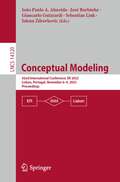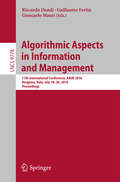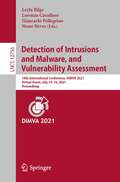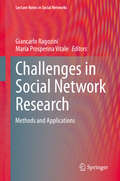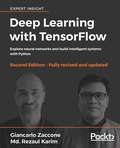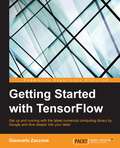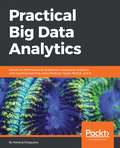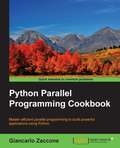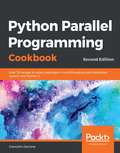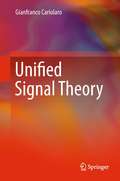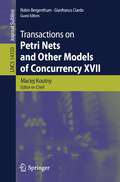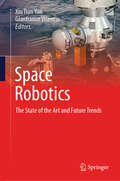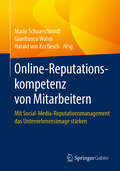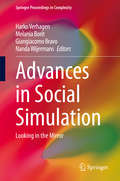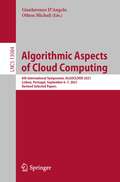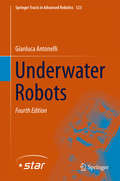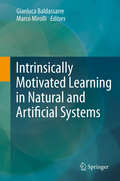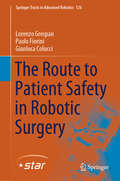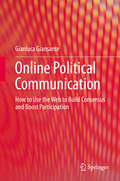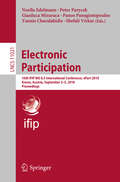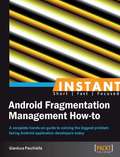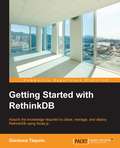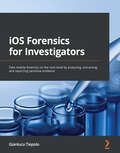- Table View
- List View
Conceptual Modeling: 42nd International Conference, ER 2023, Lisbon, Portugal, November 6–9, 2023, Proceedings (Lecture Notes in Computer Science #14320)
by Sebastian Link Giancarlo Guizzardi Jelena Zdravkovic José Borbinha João Paulo A. AlmeidaThis book constitutes the refereed proceedings of the 42nd International Conference on Conceptual Modeling, ER 2023, held in Lisbon, Portugal, during November 6-9, 2023. The 21 full papers were carefully reviewed and selected from 121 submissions. Additionally, the book contains 4 keynote speeches and 3 tutorials, and one invited paper corresponding to one of the keynote speeches. The papers cover a broad spectrum of classical and modern topics on conceptual modeling, including research and practice in the theories of concepts and ontologies, techniques for transforming conceptual models into effective implementations, and methods and tools for developing and communicating conceptual models.
Algorithmic Aspects in Information and Management: 11th International Conference, AAIM 2016, Bergamo, Italy, July 18-20, 2016, Proceedings (Lecture Notes in Computer Science #9778)
by Riccardo Dondi Guillaume Fertin Giancarlo MauriThis volume constitutes the proceedings of the 11th International Conference on Algorithmic Aspects in Information and Management, AAIM 2016, held in Bergamo, Italy, in July 2016. The 18 revised full papers presented were carefully reviewed and selected from 41 submissions. The papers deal with current trends of research on algorithms, data structures, operation research, combinatorial optimization and their applications.
Detection of Intrusions and Malware, and Vulnerability Assessment: 18th International Conference, DIMVA 2021, Virtual Event, July 14–16, 2021, Proceedings (Lecture Notes in Computer Science #12756)
by Nuno Neves Leyla Bilge Lorenzo Cavallaro Giancarlo PellegrinoThis book constitutes the proceedings of the 18th International Conference on Detection of Intrusions and Malware, and Vulnerability Assessment, DIMVA 2021, held virtually in July 2021.The 18 full papers and 1 short paper presented in this volume were carefully reviewed and selected from 65 submissions. DIMVA serves as a premier forum for advancing the state of the art in intrusion detection, malware detection, and vulnerability assessment. Each year, DIMVA brings together international experts from academia, industry, and government to present and discuss novel research in these areas.Chapter “SPECULARIZER: Detecting Speculative Execution Attacks via Performance Tracing” is available open access under a Creative Commons Attribution 4.0 International License via link.springer.com.
Challenges in Social Network Research: Methods and Applications (Lecture Notes in Social Networks)
by Giancarlo Ragozini Maria Prosperina VitaleThe book includes both invited and contributed chapters dealing with advanced methods and theoretical development for the analysis of social networks and applications in numerous disciplines. Some authors explore new trends related to network measures, multilevel networks and clustering on networks, while other contributions deepen the relationship among statistical methods for data mining and social network analysis. Along with the new methodological developments, the book offers interesting applications to a wide set of fields, ranging from the organizational and economic studies, collaboration and innovation, to the less usual field of poetry. In addition, the case studies are related to local context, showing how the substantive reasoning is fundamental in social network analysis. The list of authors includes both top scholars in the field of social networks and promising young researchers. All chapters passed a double blind review process followed by the guest editors. This edited volume will appeal to students, researchers and professionals.
Deep Learning with TensorFlow - Second Edition: Explore Neural Networks And Build Intelligent Systems With Python, 2nd Edition
by Giancarlo Zaccone Rezaul Karim<P><P>Delve into neural networks, implement deep learning algorithms, and explore layers of data abstraction with the help of TensorFlow. <P><P>Key Features <P><P>Learn how to implement advanced techniques in deep learning with Google's brainchild, TensorFlow <P><P>Explore deep neural networks and layers of data abstraction with the help of this comprehensive guide <P><P>Gain real-world contextualization through some deep learning problems concerning research and application <P><P>Book Description <P><P>Deep learning is a branch of machine learning algorithms based on learning multiple levels of abstraction. Neural networks, which are at the core of deep learning, are being used in predictive analytics, computer vision, natural language processing, time series forecasting, and to perform a myriad of other complex tasks. <P><P>This book is conceived for developers, data analysts, machine learning practitioners and deep learning enthusiasts who want to build powerful, robust, and accurate predictive models with the power of TensorFlow, combined with other open source Python libraries. <P><P>Throughout the book, you'll learn how to develop deep learning applications for machine learning systems using Feedforward Neural Networks, Convolutional Neural Networks, Recurrent Neural Networks, Autoencoders, and Factorization Machines. Discover how to attain deep learning programming on GPU in a distributed way. <P><P>You'll come away with an in-depth knowledge of machine learning techniques and the skills to apply them to real-world projects. <P><P>What you will learn <P><P>Apply deep machine intelligence and GPU computing with TensorFlow <P><P>Access public datasets and use TensorFlow to load, process, and transform the data <P><P>Discover how to use the high-level TensorFlow API to build more powerful applications <P><P>Use deep learning for scalable object detection and mobile computing <P><P>Train machines quickly to learn from data by exploring reinforcement learning techniques <P><P>Explore active areas of deep learning research and applications <P><P>Who This Book Is For <P><P>The book is for people interested in machine learning and machine intelligence. A rudimentary level of programming in one language is assumed, as is a basic familiarity with computer science techniques and technologies, including a basic awareness of computer hardware and algorithms. Some competence in mathematics is needed to the level of elementary linear algebra and calculus.
Deep Learning with TensorFlow: Explore neural networks and build intelligent systems with Python, 2nd Edition
by Giancarlo Zaccone Md. Rezaul KarimDelve into neural networks, implement deep learning algorithms, and explore layers of data abstraction with the help of TensorFlow v1.7.Key Features Learn how to implement advanced techniques in deep learning with Google's brainchild, TensorFlow v1.7 Explore deep neural networks and layers of data abstraction with the help of this comprehensive guide Gain real-world contextualization through some deep learning problems concerning research and applicationBook DescriptionDeep learning is a branch of machine learning algorithms based on learning multiple levels of abstraction. Neural networks, which are at the core of deep learning, are being used in predictive analytics, computer vision, natural language processing, time series forecasting, and to perform a myriad of other complex tasks.This book is conceived for developers, data analysts, machine learning practitioners and deep learning enthusiasts who want to build powerful, robust, and accurate predictive models with the power of TensorFlow v1.7, combined with other open source Python libraries. Throughout the book, you’ll learn how to develop deep learning applications for machine learning systems using Feedforward Neural Networks, Convolutional Neural Networks, Recurrent Neural Networks, Autoencoders, and Factorization Machines. Discover how to attain deep learning programming on GPU in a distributed way.You'll come away with an in-depth knowledge of machine learning techniques and the skills to apply them to real-world projects.What you will learn Apply deep machine intelligence and GPU computing with TensorFlow v1.7 Access public datasets and use TensorFlow to load, process, and transform the data Discover how to use the high-level TensorFlow API to build more powerful applications Use deep learning for scalable object detection and mobile computing Train machines quickly to learn from data by exploring reinforcement learning techniques Explore active areas of deep learning research and applicationsWho this book is forThe book is for people interested in machine learning and machine intelligence. A rudimentary level of programming in one language is assumed, as is a basic familiarity with computer science techniques and technologies, including a basic awareness of computer hardware and algorithms. Some competence in mathematics is needed to the level of elementary linear algebra and calculus.
Getting Started with TensorFlow
by Giancarlo ZacconeGet up and running with the latest numerical computing library by Google and dive deeper into your data! About This Book * Get the first book on the market that shows you the key aspects TensorFlow, how it works, and how to use it for the second generation of machine learning * Want to perform faster and more accurate computations in the field of data science? This book will acquaint you with an all-new refreshing library--TensorFlow! * Dive into the next generation of numerical computing and get the most out of your data with this quick guide Who This Book Is For This book is dedicated to all the machine learning and deep learning enthusiasts, data scientists, researchers, and even students who want to perform more accurate, fast machine learning operations with TensorFlow. Those with basic knowledge of programming (Python and C/C++) and math concepts who want to be introduced to the topics of machine learning will find this book useful. What You Will Learn * Install and adopt TensorFlow in your Python environment to solve mathematical problems * Get to know the basic machine and deep learning concepts * Train and test neural networks to fit your data model * Make predictions using regression algorithms * Analyze your data with a clustering procedure * Develop algorithms for clustering and data classification * Use GPU computing to analyze big data In Detail Google's TensorFlow engine, after much fanfare, has evolved in to a robust, user-friendly, and customizable, application-grade software library of machine learning (ML) code for numerical computation and neural networks. This book takes you through the practical software implementation of various machine learning techniques with TensorFlow. In the first few chapters, you'll gain familiarity with the framework and perform the mathematical operations required for data analysis. As you progress further, you'll learn to implement various machine learning techniques such as classification, clustering, neural networks, and deep learning through practical examples. By the end of this book, you'll have gained hands-on experience of using TensorFlow and building classification, image recognition systems, language processing, and information retrieving systems for your application. Style and approach Get quickly up and running with TensorFlow using this fast-paced guide. You will get to know everything that can be done with TensorFlow and we'll show you how to implement it in your environment. The examples in the book are from the core of the computation industry--something you can connect to and will find familiar.
Practical Big Data Analytics: Hands-on techniques to implement enterprise analytics and machine learning using Hadoop, Spark, NoSQL and R
by Giancarlo Zaccone Serguei Boldyrev Nataraj Dasgupta Patrick HannahGet command of your organizational Big Data using the power of data science and analytics Key Features A perfect companion to boost your Big Data storing, processing, analyzing skills to help you take informed business decisions Work with the best tools such as Apache Hadoop, R, Python, and Spark for NoSQL platforms to perform massive online analyses Get expert tips on statistical inference, machine learning, mathematical modeling, and data visualization for Big Data Book Description Big Data analytics relates to the strategies used by organizations to collect, organize and analyze large amounts of data to uncover valuable business insights that otherwise cannot be analyzed through traditional systems. Crafting an enterprise-scale cost-efficient Big Data and machine learning solution to uncover insights and value from your organization's data is a challenge. Today, with hundreds of new Big Data systems, machine learning packages and BI Tools, selecting the right combination of technologies is an even greater challenge. This book will help you do that. With the help of this guide, you will be able to bridge the gap between the theoretical world of technology with the practical ground reality of building corporate Big Data and data science platforms. You will get hands-on exposure to Hadoop and Spark, build machine learning dashboards using R and R Shiny, create web-based apps using NoSQL databases such as MongoDB and even learn how to write R code for neural networks. By the end of the book, you will have a very clear and concrete understanding of what Big Data analytics means, how it drives revenues for organizations, and how you can develop your own Big Data analytics solution using different tools and methods articulated in this book. What you will learn - Get a 360-degree view into the world of Big Data, data science and machine learning - Broad range of technical and business Big Data analytics topics that caters to the interests of the technical experts as well as corporate IT executives - Get hands-on experience with industry-standard Big Data and machine learning tools such as Hadoop, Spark, MongoDB, KDB+ and R - Create production-grade machine learning BI Dashboards using R and R Shiny with step-by-step instructions - Learn how to combine open-source Big Data, machine learning and BI Tools to create low-cost business analytics applications - Understand corporate strategies for successful Big Data and data science projects - Go beyond general-purpose analytics to develop cutting-edge Big Data applications using emerging technologies Who this book is for The book is intended for existing and aspiring Big Data professionals who wish to become the go-to person in their organization when it comes to Big Data architecture, analytics, and governance. While no prior knowledge of Big Data or related technologies is assumed, it will be helpful to have some programming experience.
Python Parallel Programming Cookbook
by Giancarlo ZacconeMaster efficient parallel programming to build powerful applications using Python About This Book * Design and implement efficient parallel software * Master new programming techniques to address and solve complex programming problems * Explore the world of parallel programming with this book, which is a go-to resource for different kinds of parallel computing tasks in Python, using examples and topics covered in great depth Who This Book Is For Python Parallel Programming Cookbook is intended for software developers who are well versed with Python and want to use parallel programming techniques to write powerful and efficient code. This book will help you master the basics and the advanced of parallel computing. What You Will Learn * Synchronize multiple threads and processes to manage parallel tasks * Implement message passing communication between processes to build parallel applications * Program your own GPU cards to address complex problems * Manage computing entities to execute distributed computational tasks * Write efficient programs by adopting the event-driven programming model * Explore the cloud technology with DJango and Google App Engine * Apply parallel programming techniques that can lead to performance improvements In Detail Parallel programming techniques are required for a developer to get the best use of all the computational resources available today and to build efficient software systems. From multi-core to GPU systems up to the distributed architectures, the high computation of programs throughout requires the use of programming tools and software libraries. Because of this, it is becoming increasingly important to know what the parallel programming techniques are. Python is commonly used as even non-experts can easily deal with its concepts. This book will teach you parallel programming techniques using examples in Python and will help you explore the many ways in which you can write code that allows more than one process to happen at once. Starting with introducing you to the world of parallel computing, it moves on to cover the fundamentals in Python. This is followed by exploring the thread-based parallelism model using the Python threading module by synchronizing threads and using locks, mutex, semaphores queues, GIL, and the thread pool. Next you will be taught about process-based parallelism where you will synchronize processes using message passing along with learning about the performance of MPI Python Modules. You will then go on to learn the asynchronous parallel programming model using the Python asyncio module along with handling exceptions. Moving on, you will discover distributed computing with Python, and learn how to install a broker, use Celery Python Module, and create a worker. You will also understand the StarCluster framework, Pycsp, Scoop, and Disco modules in Python. Further on, you will learn GPU programming with Python using the PyCUDA module along with evaluating performance limitations. Next you will get acquainted with the cloud computing concepts in Python, using Google App Engine (GAE), and building your first application with GAE. Lastly, you will learn about grid computing concepts in Python and using PyGlobus toolkit, GFTP and GASS COPY to transfer files, and service monitoring in PyGlobus. Style and approach A step-by-step guide to parallel programming using Python, with recipes accompanied by one or more programming examples. It is a practically oriented book and has all the necessary underlying parallel computing concepts.
Python Parallel Programming Cookbook: Over 70 recipes to solve challenges in multithreading and distributed system with Python 3, 2nd Edition
by Giancarlo ZacconeImplement effective programming techniques in Python to build scalable software that saves time and memory Key Features Design distributed computing systems and massive computational tasks coherently Learn practical recipes with concise explanations that address development pain points encountered while coding parallel programs Understand how to host your parallelized applications on the cloud Book Description Nowadays, it has become extremely important for programmers to understand the link between the software and the parallel nature of their hardware so that their programs run efficiently on computer architectures. Applications based on parallel programming are fast, robust, and easily scalable. This updated edition features cutting-edge techniques for building effective concurrent applications in Python 3.7. The book introduces parallel programming architectures and covers the fundamental recipes for thread-based and process-based parallelism. You'll learn about mutex, semaphores, locks, queues exploiting the threading, and multiprocessing modules, all of which are basic tools to build parallel applications. Recipes on MPI programming will help you to synchronize processes using the fundamental message passing techniques with mpi4py. Furthermore, you'll get to grips with asynchronous programming and how to use the power of the GPU with PyCUDA and PyOpenCL frameworks. Finally, you'll explore how to design distributed computing systems with Celery and architect Python apps on the cloud using PythonAnywhere, Docker, and serverless applications. By the end of this book, you will be confident in building concurrent and high-performing applications in Python. What you will learn Synchronize multiple threads and processes to manage parallel tasks Use message passing techniques to establish communication between processes to build parallel applications Program your own GPU cards to address complex problems Manage computing entities to execute distributed computational task Write efficient programs by adopting the event-driven programming model Explore cloud technology with Django and Google App Engine Apply parallel programming techniques that can lead to performance improvements Who this book is for The Python Parallel Programming Cookbook is for software developers who are well-versed with Python and want to use parallel programming techniques to write powerful and efficient code. This book will help you master the basics and the advanced of parallel computing.
Unified Signal Theory
by Gianfranco CariolaroUnified Signal Theory is an indispensible textbook dealing with the theory of deterministic signals; a topic of fundamental interest to graduates and senior undergraduates in the areas of information engineering (telecommunications, control, systems theory and electronics), astronomy, oceanography, earth science, biology and medicine. The unified theory follows an innovative approach - that of combining all signal classes into just one. The fundamental signal operations (convolution, Fourier transform, linear systems, sampling and interpolation) are established simultaneously for all the signal classes. This unified approach avoids the repetition of similar concepts consequent on other approaches' separate treatment of definitions and properties for each signal class. Modern wavelet ideas are developed in harmony with the rest of the text. Unified Signal Theory provides: * exercises and examples, to give the student practice; * solutions which are available for download and save the tutor time; and * a choice of two suggested reading paths depending on the level of the student, for an enhanced learning experience. The advantages of the unified approach are many: it permits a global vision of the topic, it is economical in teaching and learning, and it can be adjusted easily to fit new applications. This textbook presents the theory in five chapters, and goes on to demonstrate specific applications such as fast Fourier transform implementation, sampling and reconstructions of signals, and multicolor modulation systems, in a further six chapters. Mathematical concepts are introduced conceptually within the body of the book with more rigorous treatment being reserved for the appendices.
Transactions on Petri Nets and Other Models of Concurrency XVII (Lecture Notes in Computer Science #14150)
by Maciej Koutny Gianfranco Ciardo Robin BergenthumTransactions on Petri Nets and Other Models of Concurrency (ToPNoC) XVII. These Transactions publish archival papers in the broad area of Petri nets and other models of concurrency, ranging from theoretical work to tool support and industrial applications. ToPNoC issues are published as LNCS volumes, and hence are widely distributed and indexed. This Journal has its own Editorial Board which selects papers based on a rigorous two-stage refereeing process. ToPNoC contains: – Revised versions of a selection of the best papers from workshops and tutorials at the annual Petri net conferences – Special sections/issues within particular subareas (similar to those published in the Advances in Petri Nets series) – Other papers invited for publication in ToPNoC – Papers submitted directly to ToPNoC by their authors The 17th volume of ToPNoC contains revised and extended versions of a selection of the best workshop and tutorial papers presented at the 43rd International Conference on Application and Theory of Petri Nets and Concurrency, Petri Nets 2022. The papers cover a diverse range of topics including model checking and system verification, refinement and synthesis, foundational work on specific classes of Petri nets, and innovative applications of Petri nets and other models of concurrency. Application areas covered in this volume are: process mining, verification, formal semantics, distributed simulations, business processes, distributed systems, and net synthesis. Thus, this volume gives a good overview of ongoing research on concurrent systems and Petri nets.
Space Robotics: The State of the Art and Future Trends
by Xiu Tian Yan Gianfranco VisentinThis book presents the latest research findings from leading space robotic researchers around the world, together with contributions from leading space systems industrialists on the practical aspects of research and development in space robotics. The book also considers future challenges and trends to provide a ‘look ahead’ for space robotics. The European Commission set up the “Space Robotic Technologies” Strategic Research Cluster (SRC) in its flagship funding programme Horizon 2020, with the goal of enabling major advances in strategic key points of Space Robotics Technologies, in order to improve European competitiveness. Space robotics have advanced rapidly in recent years, as reflected in recent successful space exploration missions like NASA’s successful landing and operation of the Curiosity rover on Mars, and the European Space Agency’s equally successful landing of its Philae probe on comet 67P/Churyumov–Gerasimenko. These advances have inspired many young graduates and undergraduates to study space robotics.
Online-Reputationskompetenz von Mitarbeitern: Mit Social-Media-Reputationsmanagement das Unternehmensimage stärken
by Gianfranco Walsh Mario Schaarschmidt Harald Von Korflesch?In diesem Buch dreht sich alles um das Online-Reputationsmanagement. Dabei geht es um die Fragen, wie Mitarbeiter Social Media nutzen und welchen Einfluss Sie damit auf das Image eines Unternehmens haben können.Mit klaren Handlungsanweisungen zeigt Ihnen dieses Buch, wie Sie mithilfe eines sinnvollen Online-Reputationsmanagements Ihre Mitarbeiter in Bezug auf Risiken und Gefahren, die von Social Media ausgehen, wappnen können.Die Autoren beschäftigen sich mit verschiedenen Phänomenen, die in Zusammenhang mit den Mitarbeitern eines Unternehmens interessant sind. Es geht beispielsweise um Strategien zur Messung der Social-Media-Kompetenz eines Mitarbeiters in Bezug auf die Unternehmensreputation oder die Analyse von Unternehmensbewertungsportalen.
Advances in Social Simulation: Looking in the Mirror (Springer Proceedings in Complexity)
by Harko Verhagen Melania Borit Giangiacomo Bravo Nanda WijermansThis book presents the state-of-the-art in social simulation as presented at the Social Simulation Conference 2018 in Stockholm, Sweden. It covers the developments in applications and methods of social simulation, addressing societal issues such as socio-ecological systems and policy making. Methodological issues discussed include large-scale empirical calibration, model sharing and interdisciplinary research, as well as decision making models, validation and the use of qualitative data in simulation modeling. Research areas covered include archaeology, cognitive science, economics, organization science, and social simulation education.This collection gives readers insight into the increasing use of social simulation in both its theoretical development and in practical applications such as policy making whereby modelling and the behavior of complex systems is key. The book will appeal to students, researchers and professionals in the various fields.
Algorithmic Aspects of Cloud Computing: 6th International Symposium, ALGOCLOUD 2021, Lisbon, Portugal, September 6–7, 2021, Revised Selected Papers (Lecture Notes in Computer Science #13084)
by Gianlorenzo D’Angelo Othon MichailThis book constitutes the refereed post-conference proceedings of the 6th International Symposium on Algorithmic Aspects of Cloud Computing, ALGOCLOUD 2021, held in Lisbon, Portugal, in September 2021. Due to the COVID-19 pandemic the conference was held online. The 4 revised full papers and 1 short paper were carefully reviewed and selected from 11 submissions. The aim of the symposium is to present research activities and results on topics related to algorithmic, design, and development aspects of modern cloud-based systems.
Underwater Robots: Motion And Force Control Of Vehicle-manipulator Systems (Springer Tracts In Advanced Robotics #96)
by Gianluca AntonelliA classic in underwater robotics. One of the first volumes in the “Springer Tracts in Advanced Robotics” series, it has been a bestseller through the previous three editions. Fifteen years after the publication of the first edition, the fourth edition comes to print. The book addresses the main control aspects in underwater manipulation tasks. With respect to the third edition, it has been revised, extended and some concepts better clustered. The mathematical model with significant impact on the control strategy is discussed. The problem of controlling a 6-degrees-of-freedoms autonomous underwater vehicle is investigated and a survey of fault detection/tolerant strategies for unmanned underwater vehicles is provided. Inverse kinematics, dynamic and interaction control for underwater vehicle-manipulator systems are then discussed. The code used to generate most of the numerical simulations is made available and briefly discussed.
Intrinsically Motivated Learning in Natural and Artificial Systems
by Marco Mirolli Gianluca BaldassarreIt has become clear to researchers in robotics and adaptive behaviour that current approaches are yielding systems with limited autonomy and capacity for self-improvement. To learn autonomously and in a cumulative fashion is one of the hallmarks of intelligence, and we know that higher mammals engage in exploratory activities that are not directed to pursue goals of immediate relevance for survival and reproduction but are instead driven by intrinsic motivations such as curiosity, interest in novel stimuli or surprising events, and interest in learning new behaviours. The adaptive value of such intrinsically motivated activities lies in the fact that they allow the cumulative acquisition of knowledge and skills that can be used later to accomplish fitness-enhancing goals. Intrinsic motivations continue during adulthood, and in humans they underlie lifelong learning, artistic creativity, and scientific discovery, while they are also the basis for processes that strongly affect human well-being, such as the sense of competence, self-determination, and self-esteem. This book has two aims: to present the state of the art in research on intrinsically motivated learning, and to identify the related scientific and technological open challenges and most promising research directions. The book introduces the concept of intrinsic motivation in artificial systems, reviews the relevant literature, offers insights from the neural and behavioural sciences, and presents novel tools for research. The book is organized into six parts: the chapters in Part I give general overviews on the concept of intrinsic motivations, their function, and possible mechanisms for implementing them; Parts II, III, and IV focus on three classes of intrinsic motivation mechanisms, those based on predictors, on novelty, and on competence; Part V discusses mechanisms that are complementary to intrinsic motivations; and Part VI introduces tools and experimental frameworks for investigating intrinsic motivations.The contributing authors are among the pioneers carrying out fundamental work on this topic, drawn from related disciplines such as artificial intelligence, robotics, artificial life, evolution, machine learning, developmental psychology, cognitive science, and neuroscience. The book will be of value to graduate students and academic researchers in these domains, and to engineers engaged with the design of autonomous, adaptive robots. The contributing authors are among the pioneers carrying out fundamental work on this topic, drawn from related disciplines such as artificial intelligence, robotics, artificial life, evolution, machine learning, developmental psychology, cognitive science, and neuroscience. The book will be of value to graduate students and academic researchers in these domains, and to engineers engaged with the design of autonomous, adaptive robots.
Intrinsically Motivated Learning in Natural and Artificial Systems
by Marco Mirolli Gianluca BaldassarreIt has become clear to researchers in robotics and adaptive behaviour that current approaches are yielding systems with limited autonomy and capacity for self-improvement. To learn autonomously and in a cumulative fashion is one of the hallmarks of intelligence, and we know that higher mammals engage in exploratory activities that are not directed to pursue goals of immediate relevance for survival and reproduction but are instead driven by intrinsic motivations such as curiosity, interest in novel stimuli or surprising events, and interest in learning new behaviours. The adaptive value of such intrinsically motivated activities lies in the fact that they allow the cumulative acquisition of knowledge and skills that can be used later to accomplish fitness-enhancing goals. Intrinsic motivations continue during adulthood, and in humans they underlie lifelong learning, artistic creativity, and scientific discovery, while they are also the basis for processes that strongly affect human well-being, such as the sense of competence, self-determination, and self-esteem.This book has two aims: to present the state of the art in research on intrinsically motivated learning, and to identify the related scientific and technological open challenges and most promising research directions. The book introduces the concept of intrinsic motivation in artificial systems, reviews the relevant literature, offers insights from the neural and behavioural sciences, and presents novel tools for research. The book is organized into six parts: the chapters in Part I give general overviews on the concept of intrinsic motivations, their function, and possible mechanisms for implementing them; Parts II, III, and IV focus on three classes of intrinsic motivation mechanisms, those based on predictors, on novelty, and on competence; Part V discusses mechanisms that are complementary to intrinsic motivations; and Part VI introduces tools and experimental frameworks for investigating intrinsic motivations.The contributing authors are among the pioneers carrying out fundamental work on this topic, drawn from related disciplines such as artificial intelligence, robotics, artificial life, evolution, machine learning, developmental psychology, cognitive science, and neuroscience. The book will be of value to graduate students and academic researchers in these domains, and to engineers engaged with the design of autonomous, adaptive robots.The contributing authors are among the pioneers carrying out fundamental work on this topic, drawn from related disciplines such as artificial intelligence, robotics, artificial life, evolution, machine learning, developmental psychology, cognitive science, and neuroscience. The book will be of value to graduate students and academic researchers in these domains, and to engineers engaged with the design of autonomous, adaptive robots.
The Route to Patient Safety in Robotic Surgery (Springer Proceedings in Advanced Robotics #126)
by Lorenzo Grespan Paolo Fiorini Gianluca ColucciThe introduction of a new technology in a consolidated field has the potential to disrupt usual practices and create a fertile ground for errors. An example is robotic surgery that is now used in most surgical specialties, pushed by technology developers and enthusiastic surgeons. To analyze the potential impact of robotic surgery on patient safety, a consortium of major European Universities started the project SAFROS whose findings are summarized and further elaborated in the three parts of this book. Part one describes safety in complex systems such as surgery, how this may disrupt the traditional surgical workflow, how safety can be monitored, and the research questions that must be posed. Part two of the book describes the main findings of this research, by identifying the risks of robotic surgery and by describing where its ancillary technologies may fail. This part addresses features and evaluation of anatomic imaging and modeling, actions in the operating room, robot monitoring and control, operator interface, and surgical training. Part three of the book draws the conclusions and offers suggestions on how to limit the risks of medical errors. One possible approach is to use automation to monitor and execute parts of an intervention, thus suggesting that robotics and artificial intelligence will be major elements of the operating room of the future.
Online Political Communication
by Gianluca GiansanteThis book provides research findings and practical information on online communication strategies in politics. Based on communication research and real-world political-campaign experience, the author examines how to use the Web and social media to create public visibility, build trust and consensus and boost political participation. It offers a useful guide for practitioners working in the political arena, as well as for those managing communication projects in institutions or companies.
Electronic Participation: 10th IFIP WG 8.5 International Conference, ePart 2018, Krems, Austria, September 3-5, 2018, Proceedings (Lecture Notes in Computer Science #11021)
by Panos Panagiotopoulos Yannis Charalabidis Peter Parycek Shefali Virkar Noella Edelmann Gianluca MisuracaThis book constitutes the proceedings of the 10th IFIP WG 8.5 International Conference on Electronic Participation, ePart 2018, held in Krems, Austria, in September 2018.The 12 revised full papers presented in this book were carefully reviewed and selected from 29 submissions. The papers are clustered under the following topical sections: general e-democracy and e-participation; digital collaboration and social media; policy modeling and policy informatics; and social innovation.
Instant Android Fragmentation Management How-to
by Gianluca PacchiellaWritten in the easy to understand Packt How-to format, this book offers the solution to the big issues in Android application development. If you want the best possible reviews for your apps, regardless of device or Android operating system, then this book is for you.
Getting Started with RethinkDB
by Gianluca TiepoloAbsorb the knowledge required to utilize, manage, and deploy RethinkDB using Node.js About This Book * Make the most of this open source, scalable database--RethinkDB --to ease the construction of web applications * Run powerful queries using ReQL, which is the most convenient language to manipulate JSON documents with * Develop fully-fledged real-time web apps using Node.js and RethinkDB Who This Book Is For Getting Started with RethinkDB is ideal for developers who are new to RethinkDB and need a practical understanding to start working with it. No previous knowledge of database programming is required, although a basic knowledge of JavaScript or Node.js would be helpful. What You Will Learn * Download and install the database on your system * Configure RethinkDB's settings and start using the web interface * Import data into RethinkDB * Run queries using the ReQL language * Create shards, replicas, and RethinkDB clusters * Use an index to improve database performance * Get to know all the RethinkDB deployment techniques In Detail RethinkDB is a high-performance document-oriented database with a unique set of features. This increasingly popular NoSQL database is used to develop real-time web applications and, together with Node.js, it can be used to easily deploy them to the cloud with very little difficulty. Getting Started with RethinkDB is designed to get you working with RethinkDB as quickly as possible. Starting with the installation and configuration process, you will learn how to start importing data into the database and run simple queries using the intuitive ReQL query language. After successfully running a few simple queries, you will be introduced to other topics such as clustering and sharding. You will get to know how to set up a cluster of RethinkDB nodes and spread database load across multiple machines. We will then move on to advanced queries and optimization techniques. You will discover how to work with RethinkDB from a Node.js environment and find out all about deployment techniques. Finally, we'll finish by working on a fully-fledged example that uses the Node.js framework and advanced features such as Changefeeds to develop a real-time web application. Style and approach This is a step-by-step book that provides a practical approach to RethinkDB programming, and is explained in a conversational, easy-to-follow style.
iOS Forensics for Investigators: Take mobile forensics to the next level by analyzing, extracting, and reporting sensitive evidence
by Gianluca TiepoloExtract crucial data and lead successful criminal investigations by infiltrating every level of iOS devicesKey FeaturesExplore free and commercial tools for carrying out data extractions and analysis for digital forensicsLearn to look for key artifacts, recover deleted mobile data, and investigate processed dataGet up and running with extracting full filesystem images and jailbreak devices to gather the most data possibleBook DescriptionProfessionals working in the mobile forensics industry will be able to put their knowledge to work with this practical guide to learning how to extract and analyze all available data from an iOS device. This book is a comprehensive, how-to guide that leads investigators through the process of collecting mobile devices and preserving, extracting, and analyzing data, as well as building a report. Complete with step-by-step explanations of essential concepts, practical examples, and self-assessment questions, this book starts by covering the fundamentals of mobile forensics and how to overcome challenges in extracting data from iOS devices. Once you've walked through the basics of iOS, you'll learn how to use commercial tools to extract and process data and manually search for artifacts stored in database files. Next, you'll find out the correct workflows for handling iOS devices and understand how to extract valuable information to track device usage. You'll also get to grips with analyzing key artifacts, such as browser history, the pattern of life data, location data, and social network forensics. By the end of this book, you'll be able to establish a proper workflow for handling iOS devices, extracting all available data, and analyzing it to gather precious insights that can be reported as prosecutable evidence.What you will learnBecome familiar with the mobile forensics workflowUnderstand how to legally seize iOS devices and preserve their dataExtract evidence through logical and filesystem acquisitionsPerform a deep-dive analysis of user data and system dataGain insights by analyzing third-party applicationsGet to grips with gathering evidence stored on iCloudWho this book is forForensic analysts and investigators interested in extending their skills to extract data from iOS devices, including system logs, device usage, and third-party application data, will find this book useful. Anyone familiar with the principles of digital forensics and looking to expand their knowledge base in deep iOS examinations will also benefit from this book.Knowledge of mobile forensic principles, data extraction, Unix/Linux terminal, and some hands-on understanding of databases and SQL query language is assumed.
